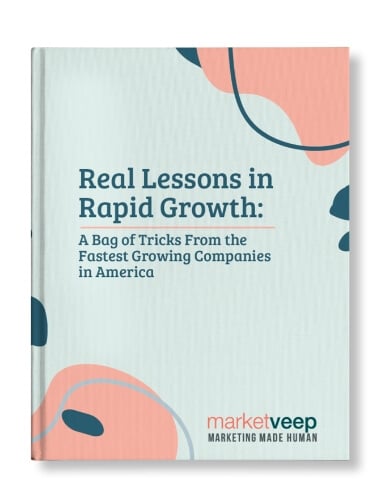Prioritize Client Delight with These 8 Easy to Measure KPIs


By Bill Viau
Happy clients drive revenue. But how do we know they’re happy? You’ve got to ask! But don’t stop there — turn the results into quantifiable KPIs so you can track, analyze, and work to improve the results. Here are eight easy to measure KPIs that will help you keep tabs on client delight.
Let’s all say it together: “The customer satisfaction metric is always right.”
Yes, satisfied clients and customers are an extremely strong measure of future success for any company. In fact, the ACSI has found that firms with high satisfaction scores are nearly five times more successful than the average Joe.
Naturally, you should be prioritizing client delight to ensure sustainable growth for your company. But you won’t know if you’re successful unless you measure it. As Peter Drucker once said, “you can't manage what you don't measure.”
This is where Key Performance Indicators (KPIs) come in. Customer experience and satisfaction metrics are a severely underrated region of KPI analysis. Consider that 97% of global consumers say customer service is somewhat-to-very-important in their choice of and loyalty to a brand. Keep track of client delight with the eight easy-to-measure metrics below, then use trends to guide strategy and tally progress towards your goals:
- Net Promoter Score (NPS)
- Customer Satisfaction (CSAT)
- Customer Effort Score (CES)
- Customer Lifetime Value (CLV)
- Churn Rate
- Retention Rate
- First Response Time
- Servqual
Lumoa identified the first six KPIs as the most popular CX metrics in their State of the Customer Experience report in 2018. According to the survey, all companies measure CX using at least one — but often a combination — of those six. After those, we’ve included two other valuable measurements worth your consideration.
So let’s get down to brass tacks. What are these KPIs, and why are they so important for prioritizing client delight?



Your Top 8 Client Delight KPIs:
1. Net Promoter Score (NPS)
NPS is one of the easiest, simplest, and most effective ways to measure client delight in your arsenal. It’s become an industry standard since its introduction in 2003, and for good reason. NPS is:
- Easy to understand
- Quick to collect
- Well-suited to open responses (for deeper analysis)
- Doubly effective (it also measures word-of-mouth marketing)
It works like this: You send out a simple survey asking customers to rate the likelihood that they’d recommend your brand to a friend, family member, colleague, or whoever else makes sense. Perhaps 1-10, like Medallia shows in this simple example:

Subtract the percentage of “detractors” (low raters) from the percentage of “promoters” (high raters) , and you’ve got your score. The example uses 9-10 as promoters and 0-6 as detractors, and the metric ignores the “passives” (7-8).
Airbnb and plenty of other global companies use NPS as a cornerstone of their customer feedback strategies. By measuring how likely your clients are to refer you to somebody else, you’re going beyond how they feel about your brand and getting to their actual intentions. This makes the rating more concrete and less likely to be a prisoner of the emotional moment.
SurveyMonkey has an easy-to-use survey template here to help you create your own NPS survey. Hotjar has a great set of example questions you could ask to gather NPS. Also, check out the Net Promoter Network to keep your results in perspective against the scores of leading companies who consistently rank at 75-85% NPS, like Apple.
2. Customer Satisfaction (CSAT)
Horst Schulze, the one-time CEO of Ritz Carlton, once wisely said:
“Unless you have 100 percent customer satisfaction...you must improve.”
Unfortunately, as Driva Solutions President Bill Price later observed:
“Customer satisfaction is everything. Measuring customer satisfaction is hard.”
It’s hard because you’re asking customers to quantify their emotions, which aren’t always cut and dry. The best approach, then, for a numerical KPI is to keep things extremely simple.
CSAT is among the most widely adopted KPIs for measuring client delight. Google, Facebook, and many other top companies use simple 1-5 rating scales after transactions or resolving support tickets to assess their customer service impact instantly. Your CSAT score is the average of all responses. This makes CSAT a simple-to-collect "right now" metric. With only a second of your client's time, you get insight into their gut reaction at the most relevant time.
HubSpot shared this great example of a 1-5 CSAT survey using clickable smileys:
The style of the 5-point scale is up to you: numbers, stars, smiley faces, or something more fanciful. Other scale ranges are possible, but five is often best — simpler scales are the least impacted by cultural differences. You can check out the industry benchmarks for CSAT scores from the American Customer Satisfaction Index to get a clearer idea of where you’re performing vs. the average business in your sector.
3. Customer Effort Score (CES)
It’s important that working with your brand feels easy. 94% of customers who had an effortless experience are likely to purchase from you again. Sue Deris, the Director of Marketing and CX at M4 Communications, asserts that “reducing effort has been found to drive loyalty.” She says CES measures your ability to cut down on friction and improve ease-of-use (pillars of the inbound marketing philosophy). “That’s why I believe CES is the best metric to predict loyalty.”
To measure it, you would ask your client to rate (often on a 1-5 or 1-7 scale) how easy it was to solve their problem or find what they need, typically right after they’ve finished. This makes it similar to CSAT, except it’s gauging their sense of the ease and simplicity in the experience.
It could look something like this one from Gartner:
Measure KPIs like CES to find your detraction drivers and root them out. The big difference between CES and NPS or CSAT is that you really need to know the distribution of scores (not just the average) to make sense of it. Multiple peaks in the distribution could indicate acute problems that only affect a certain subset of clients.
4. Customer Lifetime Value (CLV)
CLV predicts your net profit over the entirety of your relationship with a client, from the first touchpoint to the very last. To find it, multiply:
Average Value of Sale * Number of Transactions * Retention Time * Profit Margin
You could look at it either as a value each client will bring over the lifetime of their relationship or per set period (a year, five years, or whatever makes sense). A residential realtor may find lifetime more useful — folks don’t buy houses too often — whereas a clothing company might prefer a yearly average.
5. Churn Rate
Churn is the percentage of clients that stop using your products or services over a defined time period. It could also be calculated to show total lost business value, for that reason. You calculate it like this:
Number of Clients Lost Over Period / Number of Clients at Start of Period
Client delight is a priority, since churn is expensive. It’s been shown that the cost of acquiring a new customer is five times greater than the cost of retaining an existing one. Use churn rate to keep track of how you’re doing. High churn means it’s time to pay closer attention to client feedback and make changes.
6. Retention Rate
According to CX research firm Temkin Group, loyal customers are:
- 5x as likely to repurchase
- 5x as likely to forgive
- 4x as likely to refer
- 7x as likely to try a new offering
This means retention is incredibly lucrative. Your retention rate is the inverse of your churn rate — it measures how many clients you retain over a given period of time. Take the number of existing clients you have at the start of the period and compare it to the number you have left at the end (not counting any new ones gained during the period):
Pre-existing Customers at the End / Pre-existing Customers at the Start
You could calculate yearly, monthly, or even weekly in some industries. Why track it? Well, research from RJMetrics suggests you’re likely to get more than half of your revenue from returning customers. A low CES often coincides with a low retention rate, and vice versa.
7. First Response Time
Salesforce found that a quick first response is strongly associated with positive feelings about a company. Interestingly, customers preferred speed over a delayed response that was thorough (even when the quick response didn’t solve the issue).
You can make use of this insight with automated messages that comfort the customer by letting them know someone’s got their message or is working on their issue. Research has shown this makes the wait more bearable. But this isn’t truly a “first response,” so track your average time to respond and use strategies to keep it low.
8. Servqual
Servqual is a portmanteau of "service" and "quality." Developed in 1990, it's still seen as one of the best KPIs for measuring the subjective factors around quality service. It primarily uses survey questions to measure five specific elements of quality: reliability, assurance, tangibles, empathy, and responsiveness. Rather than polling general client delight, you ask clients to rate how your service compared to their expectations.
Here’s a sample SERVQUAL survey as an example. You’d measure KPIs by calculating the difference between perceived and expected service in each of the five dimensions.
Do I Use Them All?
Most companies pick 2-3 and just measure KPIs in those focused areas to assess overall client delight. Pick the ones that are most relevant to your business and try not to burden clients with requests for feedback unless you know you’re going to analyze and learn from it.
Often, the combination of one business metric like churn, retention, or CLV and one customer experience metric like NPS or CSAT will do the trick.
Whatever you do, remember that client delight is the goal! Take what you’ve learned and use it to improve your business.
Get The Latest From
Market Veep
RELATED ARTICLES

Master Sales Funnel Strategies: Tofu Mofu Bofu!
Between SEO, SEM, and SERPS, we’re always finding clever ways to break down concepts into four...

Why B2B Demand Generation Strategies Work
The sparkly, PR rep cousin of lead generation, this approach is all about growing your audience by...

Key Marketing Strategies for Robotics Manufacturers
In fact, experts project that the U.S. Robotics market is on track to pull in $7.85 billion in 2024...

Get Growing!
Download our eBook and get advice from 8 CEOs of Inc. 5000 companies in their own words.

GREAT MARKETING PARTNER
Market Veep is a great firm that handles all of our marketing efforts. This is the second time that I have used the firm. I highly recommend Market Veep!

Cres F.

EXCEPTIONAL EXPERIENCE
Market Veep's Onboarding Experts in Inbound Marketing are an absolute game-changer! From the get-go, their approach was top-notch. Market Veep's team has undoubtedly set the bar high for excellence in inbound marketing. Five stars aren't enough to commend their outstanding service!

Matthew W.

BEST PARTNER EVER!
As a growing business, setting up our first-ever HubSpot account was a crucial step towards enhancing our marketing and customer management strategies. From the moment we contacted MarketVeep, their team demonstrated professionalism, expertise, and a genuine desire to help us succeed. Overall, our experience with MarketVeep was exceptional, and we couldn't be happier with the results. Thanks to their guidance, we are now utilizing HubSpot to its fullest potential, streamlining our marketing efforts, and nurturing leads more effectively.

Jean M.

SET UP FOR SUCCESS!
We had an exceptional experience with Market Veep! Their team is professional, super organized, and friendly, and I truly enjoyed working with them. They executed on time and made the process super easy with their organization and documentation. In addition, they provided additional guidance and answered my many questions as I was new to HubSpot, and provided documentation resources for future use. We're now set up to leverage all that HubSpot marketing has to offer, and we couldn't have done it without Market Veep's expertise.

Bailey G.

OUTSTANDING WORK
There aren't enough words to describe the outstanding, professional work MarketVeep has provided to our company. From start to finish, the website design/development team at MarketVeep assigned to our project was extremely knowledgable, respectful, efficient and timely. The results went above and beyond our expectations and we could not be more thrilled with the improvements to the user experience on our website! Bravo MarketVeep, we'll absolutely be back with more projects!

Nadine B.

5 STARS FOR MARKET VEEP!
We had a fantastic experience with Market Veep! Their expert team seamlessly guided us through implementing HubSpot and provided comprehensive training across Sales, Service, and Marketing Hubs. Their knowledge and support significantly enhanced our workflow and overall efficiency. Highly recommend Market Veep for top-notch HubSpot solutions!

Anneke C.







